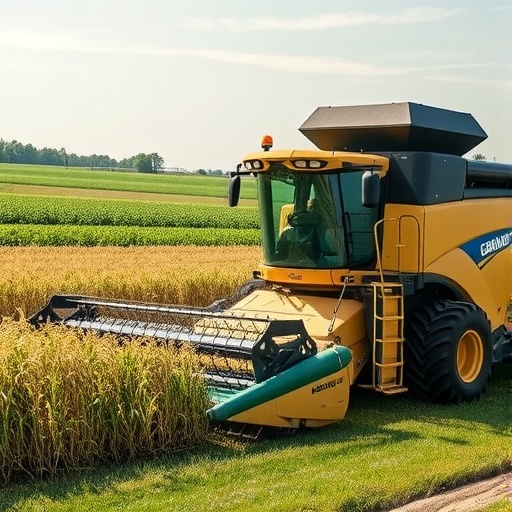In the merging fields of agriculture and technology, researchers are continuously seeking innovative ways to enhance productivity and sustainability. A recent study by Ahamed et al. has unveiled a compelling model aimed at optimizing the speed of combine harvesters, which are critical machinery in paddy harvesting. The researchers focused on addressing a pressing issue in the agricultural sector: harvesting losses of paddy crops, which can significantly impact yield and profitability for farmers.
For many farmers worldwide, the efficient harvesting of rice is not merely a logistical concern but a matter of economic survival. In regions where paddy is a staple crop, the adoption of advanced machinery like combine harvesters is essential for increasing efficiency and reducing labor costs. However, one of the pivotal challenges that these farmers face is the significant losses incurred during the harvesting process due to various inefficiencies. The researchers aimed to tackle this challenge by modeling combine harvester speed to minimize these losses, which has far-reaching implications for agricultural productivity.
The study meticulously details the methodology behind the modeling process. By employing sophisticated statistical techniques and agricultural data analysis, Ahamed and his colleagues sought to determine the optimal speed at which combine harvesters should operate to minimize paddy losses. This approach is grounded in a comprehensive understanding of crop dynamics, machine capabilities, and environmental conditions. The researchers meticulously gathered data from actual paddy harvests, enabling them to create a model that reflects real-world scenarios.
A crucial aspect of the research was the analysis of the relationship between various factors, including machine speed, crop characteristics, and environmental variables. The researchers discovered that operating at suboptimal speeds could lead to increased harvesting losses. Additionally, they noted that excessive speeds could create unintended consequences, such as crop damage and reduced grain quality. By striking a balance between these variables, the study presents a pathway for farmers to significantly reduce their losses and enhance their returns.
The findings of this research are particularly relevant in the context of climate change and the increasing demands placed on the agricultural sector. As farmers are compelled to adapt to changing weather patterns and fluctuating prices, optimizing harvesting techniques becomes paramount. The model proposed by Ahamed et al. offers a scalable solution that can be adapted to different types of paddy varieties and harvesting conditions. This adaptability enhances its relevancy across diverse agricultural landscapes, particularly in developing countries where paddy is a key food source.
Importantly, the implications of this research extend beyond paddy farmers alone. The sustainable practices highlighted in the study underscore a broader movement towards technology-driven agriculture, which aims to enhance food security globally. In an era where populations are growing and arable land is becoming increasingly scarce, innovations like this model can play an essential role in securing the future of food production.
Moreover, the model facilitates better decision-making for farmers, as it provides them with insights that can be directly applied to their harvesting practices. By understanding the optimal speed for their combine harvesters, farmers can align their operations with best practices that mitigate losses and promote sustainability. This is particularly crucial in regions where resource allocation is limited, and every grain counts towards their livelihoods.
Another significant aspect of this research is its potential for integration into existing agricultural practices. With the increasing digitization of farming through technologies such as IoT and precision agriculture, the proposed model can be embedded within agricultural machinery to provide real-time adjustments based on environmental and operational data. This integration represents a stride towards smart farming, where technology and traditional practices converge to enhance productivity.
The implications of this study also resonate in the broader context of agricultural policy. Policymakers and stakeholders in the agricultural sector could leverage these findings to promote training and education programs that empower farmers with the knowledge to implement speed optimization techniques effectively. Such initiatives may lead to the development of standardized practices that can raise the bar for paddy harvesting, ultimately contributing to increased food security.
As agricultural systems become increasingly complex and intertwined with technological advancements, the importance of research like this cannot be overstated. The model proposed by Ahamed et al. paves the way for future studies to further explore the intersection of machinery and ecology, and how these elements can be harmonized for the benefit of farmers and consumers alike. Emphasizing the need for ongoing research and collaboration among scientists, engineers, and agriculturalists will be essential in fostering innovations that continue to drive this sector forward.
In conclusion, the research conducted by Ahamed and his team presents a significant step towards addressing the challenge of harvesting losses in paddy crops through combine harvester speed modeling. This innovative approach not only aims to enhance productivity and sustainability but also offers practical solutions that farmers can adopt. As the agricultural landscape continues to evolve, such research illustrates the critical role that technology can play in fostering a resilient and sustainable food system.
Subject of Research: Combine harvester speed modeling to reduce paddy harvesting losses.
Article Title: Modeling of a combine harvester speed for reducing harvesting loss of paddy.
Article References:
Ahamed, S., Hossain, M.J., Ali, M.R. et al. Modeling of a combine harvester speed for reducing harvesting loss of paddy. Discov Agric 3, 109 (2025). https://doi.org/10.1007/s44279-025-00297-2
Image Credits: AI Generated
DOI:
Keywords: Combine harvester, paddy harvesting loss, agricultural technology, optimization, speed modeling.




